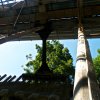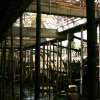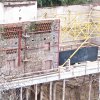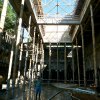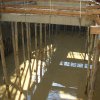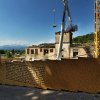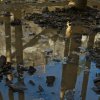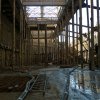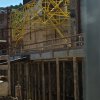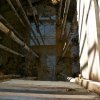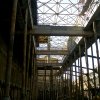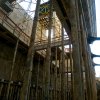Project
Scompiglio is a garden in which nature, always in motion, develops in dialogue with human beings and with their needs and their longings, both physical and spiritual. A place where one can be nourished by beauty and content, to breathe, play, move, rest and even make mistakes.
In this garden, in a continuum, cultivation and culture - by giving and taking, by feeling and acting - constitute a single organism in which each part has no meaning without the others.
Just as for the human being.

The main nucleus of the Tenuta dello Scompiglio is an area of 50 hectares. Situated in the Vorno hills, it includes a centuries-old park with a villa that blends into a vast landscaped area creating a single large garden to the edge of the woods, agricultural areas and some restored farmhouses, which at present host artists-in-residence and collaborators.
Among the buildings dedicated to the Dello Scompiglio activities, refurbished according to the techniques of bioarchitecture, energy saving and environmental sustainability, are the Performance and Exhibition Space (SPE - Spazio Performatico ed Espositivo), the Cucina Dello Scompiglio restaurant and the Square House. The latter houses the offices of the cultural association (Associazione Culturale Dello Scompiglio) and the agricultural, land and forest management (Azienda Agricola), the spaces for preparing and conserving fruit and vegetable products, the wine cellar and a room for Feldenkrais® Method classes.
For centuries, the estate had been a self-sufficient farm, cultivating mainly olives, vines and fruit. Then, over several decades, it was abandoned and nature regained the upper hand, covering the surfaces with brambles and pines. The human imprint influences and structures nature, which, when left to itself, conquers its dominion in a disorderly way. Once the human being has interfered in an ecosystem, it cannot regain its independence. For this reason, the Dello Scompiglio Project set about re-establishing a dialogue both with the present environment, with all its natural and architectural elements, and with its history, seeking contemporary forms of interaction and responsibility. It is a relationship of interdependence, exchange and symbiosis, rather than exploitation: an interaction between various organisms. The human being, with its own organism, consisting of corporeality and senses, experiences and longings, shares with other human beings the organism of the space which feeds, warms and comforts him. Dialogue and activities with the land, the woods, the wildlife, the architectural elements, the visual and performance arts in outside and inside spaces contribute to the cultural research.
Cecilia Bertoni

Project
Scompiglio is a garden in which nature, always in motion, develops in dialogue with human beings and with their needs and their longings, both physical and spiritual. A place where one can be nourished by beauty and content, to breathe, play, move, rest and even make mistakes.
In this garden, in a continuum, cultivation and culture - by giving and taking, by feeling and acting - constitute a single organism in which each part has no meaning without the others.
Just as for the human being.
The main nucleus of the Tenuta dello Scompiglio is an area of 50 hectares. Situated in the Vorno hills, it includes a centuries-old park with a villa that blends into a vast landscaped area creating a single large garden to the edge of the woods, agricultural areas and some restored farmhouses, which at present host artists-in-residence and collaborators.
Among the buildings dedicated to the Dello Scompiglio activities, refurbished according to the techniques of bioarchitecture, energy saving and environmental sustainability, are the Performance and Exhibition Space (SPE - Spazio Performatico ed Espositivo), the Cucina Dello Scompiglio restaurant and the Square House. The latter houses the offices of the cultural association ('Associazione Culturale Dello Scompiglio) and the agricultural, land and forest management (Azienda Agricola), the spaces for preparing and conserving fruit and vegetable products, the cwine cellar and a room for Feldenkrais® Method classes.
For centuries, the estate had been a self-sufficient farm, cultivating mainly olives, vines and fruit. Then, over several decades, it was abandoned and nature regained the upper hand, covering the surfaces with brambles and pines. The human imprint influences and structures nature, which, when left to itself, conquers its dominion in a disorderly way. Once the human being has interfered in an ecosystem, it cannot regain its independence. For this reason, the Dello Scompiglio Project set about re-establishing a dialogue both with the present environment, with all its natural and architectural elements, and with its history, seeking contemporary forms of interaction and responsibility. It is a relationship of interdependence, exchange and symbiosis, rather than exploitation: an interaction between various organisms. The human being, with its own organism, consisting of corporeality and senses, experiences and longings, shares with other human beings the organism of the space which feeds, warms and comforts him. Dialogue and activities with the land, the woods, the wildlife, the architectural elements, the visual and performance arts in outside and inside spaces contribute to the cultural research.
Cecilia Bertoni

SPE - Performance and Exhibition Space
Usually reviews of buildings, either new or renovated, are written when they have been completed, once they are ‘born'. Less often buildings are described in the embryonic stage of the project, before they are ‘born'. Rarely are they reflections on the ongoing construction, in an intermediary state, a work in progress, between project and final realisation. The particularity of the new complex known as Performance and Exhibition Space requires a brief progress report.
The Performance and Exhibition Space (SPE) is particular because it is part of the wider and complex project of Dello Scompiglio. This is a project to renovate the buildings and the landscape of the estate within a new cultural venture of dialogue and interaction with the elements. The building in the process of renovation, which will be used as a theatre and art gallery, is the hub of this microcosm, the central body of an updated and modern idea of cultural patronage, in which the open spaces, the land in all its varied forms - and the closed spaces - the buildings with their various functions - interact harmoniously like the ideal of the small renaissance city of days gone by.
SPE cantiere
Also particular is the specific programme to renovate the existing building intended for SPE: a collection of small adjoining buildings constructed at different times and in various styles, characterised by a tower roughly in the middle of the long edifice; these spaces will be renovated preserving their external identity and restructured internally into a single homogenous unit with a new function. The project involves the transformation of the old agricultural outbuildings into a Performance Space (dance, theatre, concerts) and the creation of a new area entirely underground, taken from the bowels of Scompiglio, for the purpose of an Exhibition Space (for visual arts). The design concept provides for and takes into account the versatility of the spaces, including a potential "reversal" of the work.
The Performance Space will be located at the western end of the new complex, have a capacity of 120 seats, and be equipped with a modern stage and scenery mechanics, as well as all the areas typical of this type of activity (foyer, rehearsal room, dressing rooms, various cloakrooms).
The Exhibition Space will consist of a collection of rooms of different sizes and double volume, which can also be used as spaces for supporting activities (library, storage, technical areas and facilities).
The complex will eventually include a range of services, from residencies for artists to theatre workshops, to services and so on, of a high standard, both technical and aesthetic, just as with other undertakings carried out at Scompiglio.
As with all the other restructured buildings of the estate, the SPE will pay equal attention to creating spaces using materials compatible with bio-architecture, fully respecting the environment and following the Dello Scompiglio policy of rational and sustainable use of resources; the cooling and heating systems will utilise geothermal techniques, exploiting the natural resources of ground source heat.
And for the rest, if it is not too banal an assumption, everything is as normal.
Now I will deal with a detail, which adds to the exceptional characteristics of the SPE; the construction of an ephemeral architecture devised to create the new underground structure, a technological frame made from raw and simple materials applied to an idea as old as forgotten, resurrected in a simple and clever manner, and which, once completed, will disappear in the dismantling of this phase of construction, finally bringing the new structure into existence.
Theatre, spectacle, display, are words always associated in the collective imagination to something fleeting, ephemeral, limited to the short duration of a standard performance.
The concept of an intrinsic architecture built specifically to create a new architecture, like a box within a box, perfectly describes the intermediate state of the construction, to illustrate a phase which, once finished, will have completely disappeared, but will have been fundamental to achieve the final result.
The most particular characteristic of the intervention was to extract the Exhibition Space from underground, without disturbing the building above: an environmental constraint obliged us to maintain the encasing perimeter walls. A system was therefore designed and implemented consisting of piles driven into the ground and connected at the ends above ground by kerbs of reinforced concrete, creating a grid of piles capable of supporting the walls of the existing building. Once this underground hidden structure was completed, excavation began, slowly bringing into existence the invisible structure, digging out the layers of earth around the piles until the required level of the concrete base of the building was reached.
The old building then appeared to be suspended in the air, supported only by a series of multiple steel poles, forming a ‘cathedral nave' composed of thin, tall, wiry columns, an empty space, constructed of raw, unfinished materials, such as steel, reinforced concrete, earth and rocks from the excavation, like the walls of a giant pool.
From this point a new casing has been created, consisting of structural elements such as reinforced concrete slab, walls, columns, beams, and floors. When completed, these elements will permanently support the existing building, rendering unnecessary the provisional support structure.
Now, whilst these lines are being written, huge blades of steel are in the process of cutting curbs and piles, and an enormous crane raises and shows off these important supports.
Descending the hill which dominates the estate, our gaze sweeps across the horizon, the skyline punctuated by the Apuan Alps, clear and perfect, in its naturalness. Approaching the area which borders the building site of the SPE and slowly lowering our gaze, we are able to admire the tower of the future Performance Space, a silent presence of the transition and transformation of the building, simple and upright, an architectural symbol of this edifice, awaiting undaunted its final completion.
A little theatre is being born from the bowels of the earth.
arch. Marco Guzzon
director of works
External Collaborators
Architects
Caturegli Formica architetti associati
Antonio Meschi
This email address is being protected from spambots. You need JavaScript enabled to view it.
Construction Technicians
Studio Techné
Construction Engineer
Massimo Bottega
This email address is being protected from spambots. You need JavaScript enabled to view it.
Executive Engineer
Serena Barbuti
This email address is being protected from spambots. You need JavaScript enabled to view it.
Site Manager
Francesco Simonetti
This email address is being protected from spambots. You need JavaScript enabled to view it.
Bio-architecture and engineering
The restorations are carried out with particular attention and respect for the environment and for people's health, using modern technologies and eco-compatible materials, and favouring the most ancient and traditional crafts. Moreover, through studying the microclimate and the resources of the elements (wood, sun and water), a range of systems for producing renewable and sustainable energy are being created. For example, a wood chip boiler is already in operation, using material obtained during the pruning and cleaning up of the woodland. Various projects are in development, including cisterns for collecting and re-using rainwater, solar panels, and passive houses which utilise the resources around the house to produce energy, having minimal impact on the environment.
Cecilia Bertoni
Organisation of Energy Resources
The Tenuta Dello Scompiglio has ample availability of natural resources distributed over an area of about 200 hectares; solar energy equivalent to about 1,600,000 MW-h/year (of which approx. 600,000 in the lower estate), water equal to approx. 2,500,000 m³ rainwater and natural springwater sources which produce approx. 50,000 m³ per year.
The objective of the project was to draw on these sources for the electricity, heat, and water requirements (an estimated demand of 4,000 MW solar energy and 10,000 m³ of water annually). All of the buildings of the lower part of the Tenuta are connected to the network. Solar energy is used indirectly to make the forest grow, which supplies the timber which fuels the woodchip boiler to provide the central heating and hot water. Solar energy will also be used directly in a photovoltaic system, when permission has been granted. Spring water feeds the potable water system and some of the rainwater is stored for non-drinking purposes. The buildings of the upper part of the Tenuta are isolated and will be equipped with autonomous energy supply systems; photovoltaic solar, thermal solar, and water. The implementations on the buildings were specific to the objectives and guidelines for energy efficiency have been applied inall details in the choice of the method of restoration. In particular we proceeded to optimize the thermodynamic aspects of the building, to improve where possible the insulation properties of building materials and to exploit the characteristics of "natural" climate control of historical buildings,which, due to their construction methods, have a higher thermal inertia. The houses of the mountain area are designated "active" or positive energy, as they are constructed with thermal insulation so as to reduce energy consumption to a minimum and are capable of producing more energythan they consume.
Massimo Bottega
Ingegneria, bioedilizia ed energie rinnovabili
External Collaborators
Architects
Caturegli Formica architetti associati
Antonio Meschi
This email address is being protected from spambots. You need JavaScript enabled to view it.
Construction Technicians
Studio Techné
Construction Engineer
Massimo Bottega
This email address is being protected from spambots. You need JavaScript enabled to view it.
Executive Engineer
Serena Barbuti
This email address is being protected from spambots. You need JavaScript enabled to view it.
Site Manager
Francesco Simonetti
This email address is being protected from spambots. You need JavaScript enabled to view it.
Architecture
The Dello Scompliglio project, begun in 2003, encompasses the restoration of all the buildings within the estate for housing and to host the activities of the cultural association and the agricultural business: performance space, exhibition space, rehearsal rooms, artists’ residences, offices, agricultural outbuildings and the restaurant, Cucina Dello Scompiglio.
The processes followed the highest standards of artisanship, and were based on close collaboration between client, architects and craftsmen, aiming for a final result that is to the personal and professional satisfaction of everyone who worked on the programme. In the final version, the architectural and historical richness of the product has been additionally highlighted by some of its own stratifications, and the fruition of the buildings becomes the key to the gradual discovery of the work that underlies their redevelopment.
Architettura
External Collaborators
Architects
Caturegli Formica architetti associati
Antonio Meschi
This email address is being protected from spambots. You need JavaScript enabled to view it.
Construction Technicians
Studio Techné
Construction Engineer
Massimo Bottega
This email address is being protected from spambots. You need JavaScript enabled to view it.
Executive Engineer
Serena Barbuti
This email address is being protected from spambots. You need JavaScript enabled to view it.
Site Manager
Francesco Simonetti
This email address is being protected from spambots. You need JavaScript enabled to view it.
